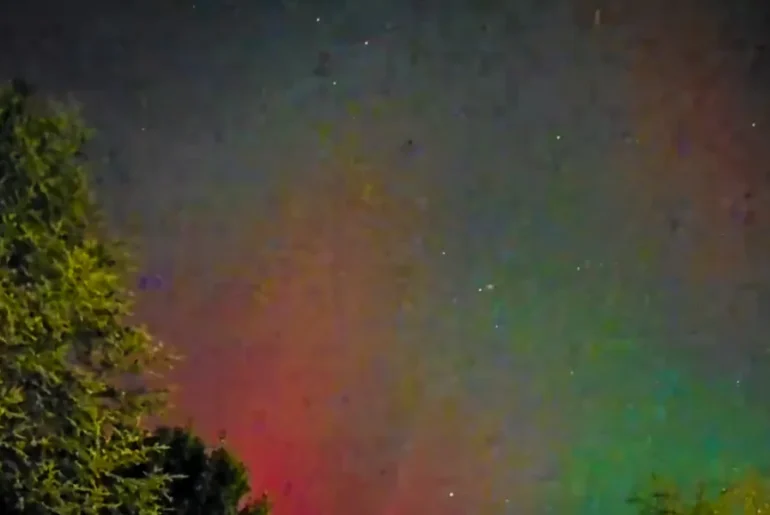The breathtaking aurora borealis may be visible this Friday night across several US states. This is thanks to a recent space phenomenon.
A geomagnetic storm pushed the northern lights further south than usual this week. As a result, the National Oceanic and Atmospheric Administration’s Space Weather Prediction Center (NWSSWPC) calculates another chance to see them at the right location on October 11, 2024, after many witnessed the event the previous day.
UPDATE! CME passage intensified; things are favorable for G4 levels to potentially continue into night hours. Keep space weather aware at https://t.co/YLUbTRM02y for the latest. We take actions to notify officials and critical infrastructure operators, so you can enjoy the aurora pic.twitter.com/uvZ7Ju0ps8
— NOAA Space Weather Prediction Center (@NWSSWPC) October 10, 2024
A KP of 5 suggests a brighter and more active aurora, potentially visible further south than usual. The aurora typically appears as a green oval centered on Earth’s magnetic pole, but it can turn red during periods of heightened activity.
G4 levels reached again! CME progression will continue overnight with periods of weakening and some escalation possible in geomagnetic storm levels. The G4 Watch remains in effect for 11 Oct and all applicable warnings remain in place. Visit https://t.co/YLUbTRMxS6 for the latest pic.twitter.com/rthy2vufUe
— NOAA Space Weather Prediction Center (@NWSSWPC) October 10, 2024
While often seen just after sunset or before sunrise, the aurora is not visible in daylight. Interestingly, it doesn’t have to be directly overhead to be seen; under ideal conditions, it can be observed from as far as 1,000 km (approximately 621 miles) away.
This celestial display isn’t just a visual wonder; it also serves as an indicator of geomagnetic storm conditions. These events can impact various technologies, including radio communication and GPS navigation.
A timelapse of the breathtaking Northern Lights over the 18th hole of Pinehurst No. 2 last night: pic.twitter.com/EA5OdpwKsu
— Pinehurst Resort (@PinehurstResort) October 11, 2024
The NWSSWPC emphasizes the aurora borealis as an exceptional opportunity for many to personally experience the wonders of space weather. It is a captivating nighttime display that entices people to journey to Arctic regions simply to witness its beauty.
i just saw the northern lights in BALTIMORE 😭 screaming crying throwing up 😭 pic.twitter.com/BNVcgRHI9a
— ele,na 𐚁 (@gumbo_skriimp) October 11, 2024
To see this event, the NWSSWPC suggests finding a location with minimal light pollution and an unobstructed view to the north. A higher vantage point, like a hill, can further enhance your viewing experience. Additionally, the optimal time to watch is usually within an hour or two of midnight, between 10 PM and 2 AM local time.
So, which states are most likely to catch this dazzling display? According to the view line calculated by the NWSSWPC, Alaska and northern parts of Washington have a higher chance of seeing it. Idaho, Montana, North Dakota, Minnesota, and Wisconsin are also in this range.
The northern lights last night over my mom’s house in Hyannis Port. pic.twitter.com/VhYpoqVqZJ
— Robert F. Kennedy Jr (@RobertKennedyJr) October 11, 2024
Other states, including Montana, South Dakota, Iowa, Wisconsin, Michigan, New York, New Hampshire, Vermont, and Maine, also have a possibility, though the likelihood is lower.
Georgians were treated to a rare sight Thursday as the northern lights lit up the sky, a stunning display usually seen further north. 🌌
Amazing to witness such beauty right here in the South!
📸 Mary Cole, Pam Brewer, Kim Cromer pic.twitter.com/D7iPUJbKBa
— Everything Georgia (@GAFollowers) October 11, 2024
Areas in the rest of the world may also see them. For example, the Meteorological Office predicts that cloudy skies will limit vision for most of the UK, except for Scotland.
This week’s stunning aurora borealis displays weren’t a surprise. The NWSSWPC issued a G4 storm watch on October 9th, 2024, following a coronal mass ejection from the Sun on October 8th.
Time lapse of the Northern Lights between 10-11PM from my front yard last night! Doylestown @6abcWeather pic.twitter.com/WEO3dr18DT
— Keith Balderston (@BucksDrones) October 11, 2024
This powerful solar event had the potential to cause significant disruptions to crucial infrastructure. “There is potential to reach G4 (Severe) upon arrival of this CME and throughout its passage,” the NWSSWPC warned. Eventually, the storm got stronger than initial predictions.
Northern Lights from my bedroom window in Lanarkshire. Amazing to see this far south 🌌 pic.twitter.com/Owa1Q2hH0L
— ᴘʙ 🍀 (@p_bov1) October 10, 2024
Therefore, this Friday night aurora borealis promises a captivating spectacle for those lucky enough to witness it. However, remember, these predictions can change depending on local weather conditions. Also, the unpredictable nature of this space phenomenon also factors into any chance of viewing.




